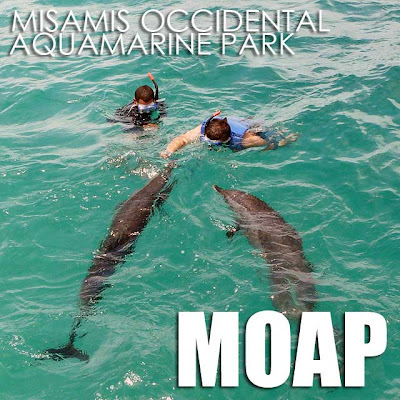
A lot of people had suggested that I visit Dolphin Island at the Misamis Occidental Aquamarine Park (MOAP) to check out their swimming with dolphins experience. It had been advertised as a Dolphin Rescue Center where injured dolphins are brought to recover. In fact, when you land in Ozamiz Airport, one of the first things you'll see is a tarpaulin promoting the place. So it was worth checking out.
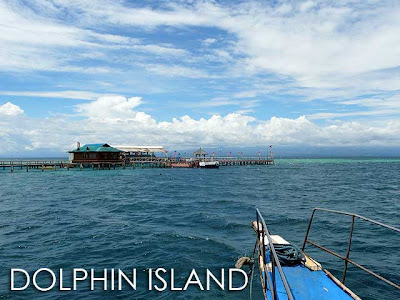
Entrance to MOAP is Php10 per head. From the MOAP Visitors' Center, you walk to the ferry port where another ticket counter will charge you Php250 for the round-trip boat ride and entrance to Dolphin Island which is about 20 minutes away.
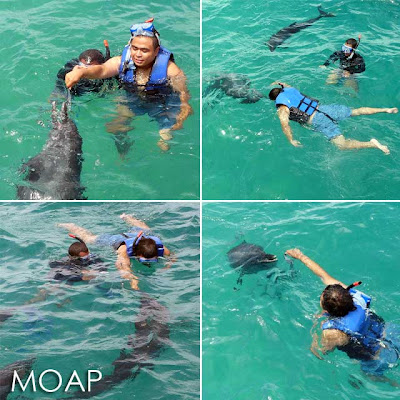
At Dolphin Island, you pay another Php300 for the swimming with the dolphins experience and gear rental. A guide will take you into the enclosure and hold the bag of fish you will feed the dolphins. To be honest, I actually enjoyed the experience because the dolphins were quite playful as I fed them the fish. Unlike the dolphin shows which has elicited a lot of opposition from animal rights activists, they do not train the dolphins here to perform any tricks. They just swim around, albeit in captivity.
I had been asked by animal rights friends to find out if the dolphins were released after. Unfortunately, MOAP does not release the dolphins even after they recover. They are kept there for entertainment purposes. While I personally understand the existence of zoos, I do not agree that MOAP should continue to call it the Dolphin Rescue Center because part of rescue is release after recovery. I mean let's be straightforward that the dolphins there are kept in captivity even after recovery. So when people visit, they know what they are visiting.
This project had been promoted by none other than President Arroyo. She visited the island together with the Australian Ambassador. From what I understand, AusAID was somehow part of this project.
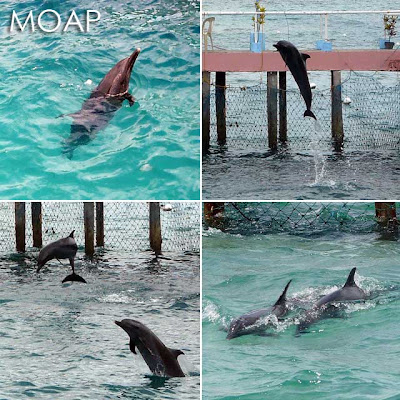
While dolphins in captivity are seen as okay by the general public (part of my childhood were visits to Ocean Park and SeaWorld), animal rights advocates are against it. Just to open the discussion, I would like to share Dolphins in Captivity: FAQs for you to learn about the issues behind dolphins in captivity. So if you do visit MOAP and try out their swimming with dolphins experience, at least these issues are clear to you.
After you swim with dolphins, your guide will offer to take you to the coral reefs around the island. There is no fee for this but you'll have to give your guide a tip. I was floored by the variety of coral and fish species around the island. My guide gave me another piece of fish which I held in the water for other fish to eat. By the time I knew it, I only had bones left! There were also a lot of Giant Clams in the area.
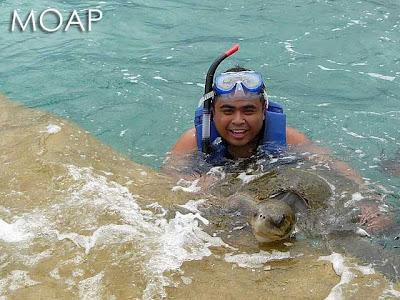
There's another pool were they keep a pawikan. But watch out because it bites! Lunch is also available on the island so no need to worry about food. During low-tide, the sand around the area surfaces. But the island disappears when it's high-tide. So you can hang around there for some swimming.
Back at the mainland, I walked around the park while waiting for my ride back to Oroquieta City. I saw a wooden bridge that led to a mangrove forest which turned out to be a zoo. I was quite disconcerted seeing a dozen or so monkeys tied up with chains around the waist to bamboo poles. Looking at them doing nothing but walking up and down the poles was not a happy experience. For a project that won the Galing Pook Award in 2005, I was a bit disappointed to see how they treated the monkeys. I hope the Provincial Government of Misamis Occidental does something about the zoo.
Anyway, I left with mixed feelings. While I genuinely enjoyed the swimming with the dolphins experience, I couldn't help but ponder on the issues behind dolphins in captivity.

Glad you enjoyed the experience.
ReplyDeleteI'll share your post (thru Facebook) so my friends (I'm from Ozamiz) will realize or be aware of the concerns/issues regarding the dolphins and the zoo.
Rehabilitation mean that they should release the dolphins! Handfeeding them is not part of their nature.
ReplyDeleteI dunno guys, my attachment to marine life was triggered by the flipper show and a dolphin show I watched in Araneta more than 30 years ago--both of which has been vociferously attacked here. As much as I respect the views you have, you also have to see how much more effective these shows and experiences are in turning children into marine life advocates. Go take a look at one of these orca or dolphin shows and watch the kids and the message the emcees try to teach the kids. Words and photos on paper are no match...nor are just adults lecturing about it...without these shows or interactions, dolphins and whales will just be another fish in the sea...
ReplyDeleteThey even pay fishermen to capture them is what I heard
ReplyDelete30 years ago we did not know much about dolphin behaviour, now it is known that they are not suited for captivity. Besides these animals are protected in the Philippines, and this facility also Ocean adventure have violated some of our laws (well you know how this works). The MOAP facility don't even have a BFAR permit.
ReplyDeleteExploitation and abuse of nature and the environment should be a thing of the past. We are talking now of sustainable use. And there are sustainable ways to know, see, and experience these animals. We live in an archipelago, we are surrounded by seas, they are all around us. There are organized whale and dolphin watching tours, take one!
Once you see happy dolphins in their wild state, you will be too!
Ive seen both, but for mass education, you cant beat this shows...how many can afford to go to a zoo vs how many can go on a wildlife safari in Africa?
ReplyDeletei agree with Yvette.
ReplyDeletethere is a difference between education (wanting to help nature) and entertainment as a business (wanting to make money).
ReplyDeleteYvette, regarding dolphins in captivity, please watch THE COVE. Flipper committed suicide.
ReplyDelete:) I was waiting for that. Why can't we accept that both can go hand in hand? When has making a profit become bad word? Look at Donsol...the profit motive is what is driving protection efforts there. That's entertainment as a business in one of its most purest forms. The same with dive fees in sanctuaries...like it or not in a third world country like ours, we need businesses to sustain our protection efforts. Yes, you can argue donsol does not have captive whale sharks and neither do marine sanctuaries, but both have damaging effects on the environmen
ReplyDeleteit is bad when something is exploited, again sustainabilty. Donsol sharks are free to swim away. Disturbed maybe, but not exploited.
ReplyDelete"We need to look at ourselves and decide, the time has come to view captivity of whales and dolphins as a part of our history, not a tragic part of our future." Jean-Michel Cousteau.
ReplyDeletecheck this out: http://www.youtube.com/watch?v=fp8MkPyBE5A
We have learned so much about our marine environment the past 30 or so years so we should use that knowledge to move forward. With the knowledge and communications technology available nowadays there are many ways to educate people about wildlife. Dolphin shows may let you see animals up close but it doesn't teach you about natural behaviour, ecology, let alone conservation. For the most part, it imparts a twisted message: that it is good to keep wild animals in captivity.
ReplyDeleteOne doesn't have to go to Africa to see wildlife. I think we are fortunate because in most places, especially for those who live outside big cities, all you have to do is step out of your backyard and see...
Between Animal Planet, National Geographic and the scores of other documentaries and films about animals in their habitat, many people are able to be reached and educated. There are other means by which people can be educated and so the need to keep animals in captivity for purely entertainment purposes is highly contentious. The irreparable damage to an animal held in captivity is undetermined. Zoos worldwide posing as research centers or rehabilitation facilities are decepting the public and are the object of controversy, particularly if they profit from the detention of wild animals. Awareness and education may be achieved by other means, but to hold an animal captive to enable people to have a close encounter with them is certainly abhorrent, in my opinion.
ReplyDeleteanimals need to perform their ecological function (in the wild) that is what they are here for and not to entertain humans in a cage
ReplyDeleteHiya Yvette! Our kids now are so much luckier - they have access to more TV and information on wildlife in the wild. These shows are also inspiring! My take on this is that we should concentrate on providing more opportunities for kids to appreciate wildlife in the wild, less expensively. I'm also thinking, middle class parents are buying consumer products for their kids who may even be too young for it, why can't they buy them a proper nature tour? The Philippines is so lucky in that sense, we have access to all kinds of ecosystems. Entrepreneurs could find ways to make them accessible, and for advocates to encourage local governments to take care of them.
ReplyDeleteMy apprehension about such facilities is that they also promote a mass consumption notion and instant gratification which causes so much environmental destruction. AND there is a danger that other entrepreneurs will follow suit and want to have their OWN dolphin in captivity facility. Such things also feed the wildlife trade. :(
My love for wildlife was not kindled by a visit to the zoo or any such facility. It was because I was often in natural environments - gubat, ilog, dagat. So there ARE many ways to inspire kids! And let's explore that together! :)
Guys, lets just respect each others' views on the matter. I appreciate where you are coming from and Anna, Bunny, yes ideally it woud be great of kids can get it through a tv show or being in the wild. But why are you so against mass education and mass consumption?. Surely busing in 400 kids has less carbon loading than having 400 bancas burning fuel to try to go watch the dolphins in the wild. Add on top of that the plane fares/fuel....
ReplyDeleteThere is no perfect solution or situation.
I'll give you another example that also hits the divers on this list closer to home. As far as I know, Ocean park here in manila does NOT have any napoleon wrasse in captivity--having acquiesced to an environmental NGO who asked them not to have in captivity any threatened species. At that time OP asked me if I thought they should and I said yes , if only for the education of the visitors.Anyway they didn't get any.
ReplyDeleteIn 2006, we had that case of the chinese fishermen (whose boat and fishermen were quietly released sept last year and early this year) whose boat was caught in Tubbataha with a load of mameng and lapu lapu.
The man on the street did not appreciate why the mameng was considered contraband.(including then DOJ Sec.Gonzalez) To him( public AND Sec Gonzalez), it was food fish because the only time they saw it was in the market! Who ended up forcing the gov't to act? The diving community!
Why?Because we've seen it for ourselves and know how beautiful it is and understood its importance. All of the people who ended up having a direct hand in forcing the gov't officials to act, to a man, and woman, had seen and interacted with the mameng on one of their dives!
I had to provide the photos to the media to stir up the public outcry we needed. It would have been a lot easier if we had a couple of these in the aquarium bec then the media and the public could have gone over , seen up close and personal how beautiful this fish is and said "aaah, yan pala yung pinagaawayan nila" and relate to what we were fighting for !
So yes, may pictures, may text and laws in the books calling for its protection and I'm sure a video or 2 esp those from palau...but honestly, which would have been more effective?
Nothing said against mass education, actually. And yup, there is no perfect situation, but we can choose. That's the great thing about being human. Mass consumption is a problem - as a planet, we've extracted/produced/bought/ thrown away so much collectively, we're destroying the habitat. Our love for marine wildlife and other wildlife should extend to their HOMES - which, as was explained - needs their presence for the survival of all the other creatures in it. Birds/dolphins need to be in the wild because they keep the balance.
ReplyDeleteNothing is perfect, but that doesn't mean we should give up, especially when as humans we have alternatives and choices and more benign techniques. The animals do not.
Re bancas, I say address that issue separately. 400 bancas is not the only way to enjoy dolphins in the wild.
Ah, but the interaction was in the wild... and that is what made it special. It's not just the animal, it is the context. :(
ReplyDeleteYes Anna, but my point here is this, considering how many thousands of dolphins get killed each month in nets as by catch, and napoleon wrasse get caught inadvertently and end up in the market--why can't we spare or cge na nga , sacrifice a few hundred if its used to entertain and educate the public--especially children? Just bec the outfits make a profit? What did the that African environmentalist say? Baba Douad or something like that?
ReplyDelete